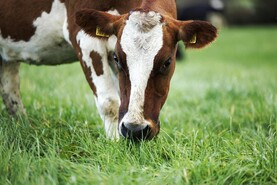Improved grazing conditions over the past week has resulted in more farmers turning freshly calved cows out to grass.
Where cows are grazing on lush swards and temperatures fluctuate between mild days and cold nights, livestock farmers should be on the alert for grass tetany.
Every precaution should be taken to ensure that cows are properly supplemented with magnesium to reduce the risk of tetany.
Outlined are five steps that can help to reduce the risk of grass tetany this spring.
Supplement with magnesium
Tetany is caused by a lack of magnesium in the cow’s diet. Cows cannot store magnesium in the body, therefore they require regular supplementation to reduce the risks associated with deficiency.
Lick buckets are a simple method to provide magnesium. The more buckets used, the better. As a rule of thumb, offer one bucket for every 10 cows in a grazing group.
Putting magnesium in water troughs can also be an effective way to supplement cows. Using a mineral bolus provides a slow release of minerals and offers long-term cover, but requires good handling facilities to ensure the bolus is properly administered.
Feed meal
Offering cows a high-magnesium ration can reduce the risk of tetany or feed your normal ration with some magnesium powder added.
Target thin cows, first-calved heifers and cows sucking twins immediately. These animals will be under nutritional stress and at higher risk of tetany. Feed 2kg to 3kg/day depending on grass supplies.
Avoid grazing swards after slurry
Slurry contains high levels of potash (K), which inhibits magnesium uptake in grass.
Therefore, where possible, avoid grazing cows on swards that have recently received slurry. These swards can be grazed by store cattle instead.
The same applies to swards than have received a compound fertiliser with a high potash content.
Do not force cows to clean out swards
Do not force freshly calved cows to graze swards out tight to the ground.
Holding cows in paddocks with low grass covers will put animals under stress and they may not be getting enough energy through grazing.
Move cows to the next paddock early and use dry cows or store cattle to clean out swards, or wait until the next rotation to clean off swards.
Offer fibre
Offering cows a forage source high in fibre, such as hay and straw, along with grazed grass is a good idea. Simply open a bale and scatter on top of ground every morning or evening.
Read more
Watch: spring calving and grazing under way in Co Derry
Too much grass in Tullamore, what a difference a year makes
Improved grazing conditions over the past week has resulted in more farmers turning freshly calved cows out to grass.
Where cows are grazing on lush swards and temperatures fluctuate between mild days and cold nights, livestock farmers should be on the alert for grass tetany.
Every precaution should be taken to ensure that cows are properly supplemented with magnesium to reduce the risk of tetany.
Outlined are five steps that can help to reduce the risk of grass tetany this spring.
Supplement with magnesium
Tetany is caused by a lack of magnesium in the cow’s diet. Cows cannot store magnesium in the body, therefore they require regular supplementation to reduce the risks associated with deficiency.
Lick buckets are a simple method to provide magnesium. The more buckets used, the better. As a rule of thumb, offer one bucket for every 10 cows in a grazing group.
Putting magnesium in water troughs can also be an effective way to supplement cows. Using a mineral bolus provides a slow release of minerals and offers long-term cover, but requires good handling facilities to ensure the bolus is properly administered.
Feed meal
Offering cows a high-magnesium ration can reduce the risk of tetany or feed your normal ration with some magnesium powder added.
Target thin cows, first-calved heifers and cows sucking twins immediately. These animals will be under nutritional stress and at higher risk of tetany. Feed 2kg to 3kg/day depending on grass supplies.
Avoid grazing swards after slurry
Slurry contains high levels of potash (K), which inhibits magnesium uptake in grass.
Therefore, where possible, avoid grazing cows on swards that have recently received slurry. These swards can be grazed by store cattle instead.
The same applies to swards than have received a compound fertiliser with a high potash content.
Do not force cows to clean out swards
Do not force freshly calved cows to graze swards out tight to the ground.
Holding cows in paddocks with low grass covers will put animals under stress and they may not be getting enough energy through grazing.
Move cows to the next paddock early and use dry cows or store cattle to clean out swards, or wait until the next rotation to clean off swards.
Offer fibre
Offering cows a forage source high in fibre, such as hay and straw, along with grazed grass is a good idea. Simply open a bale and scatter on top of ground every morning or evening.
Read more
Watch: spring calving and grazing under way in Co Derry
Too much grass in Tullamore, what a difference a year makes






 This is a subscriber-only article
This is a subscriber-only article










SHARING OPTIONS: